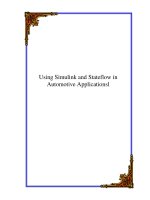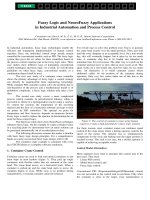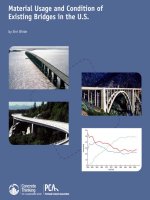Tài liệu Fuzzy Logic and NeuroFuzzy Applications in Industrial Automation docx
Bạn đang xem bản rút gọn của tài liệu. Xem và tải ngay bản đầy đủ của tài liệu tại đây (237.84 KB, 10 trang )
Fuzzy Logic and NeuroFuzzy Applications
in Industrial Automation and Process Control
Constantin von Altrock, M. Sc. E. E., M. O. R., Inform Software Corporation,
2001 Midwest Rd., Oak Brook, IL60521, www.inform-ac.com, , Phone 1-800-929-2815
In industrial automation, fuzzy logic technologies enable the
efficient and transparent implementation of human control
expertise. Here, the individual control loops mostly remain
controlled by conventional models, such as PID. The fuzzy logic
system then gives the set values for these controllers based on
the process control expertise put in the fuzzy logic rules. Three
case studies show different ways of integrating conventional
control techniques and fuzzy logic. As a result, we will develop
guidelines on when fuzzy logic, conventional models, or a
combination thereof shall be used.
The first case study of a container crane controller
shows the primary advantage of fuzzy logic: a control strategy
can directly be implemented from engineering knowledge.
While standard PID controller cannot solve the problem due to
non-linearities of the process and a mathematical model is of
prohibitive complexity, a fuzzy logic solution only takes a few
days.
The second case study covers a more complicated
process control example. In petrochemical industry, ethine is
converted to ethene in a hydrogenation reactor using a catalyst.
To control the reaction, the temperature of the incoming
material and the flow of a moderator substrate are kept to their
set points by PID controllers. The optimal set point for
temperature and flow, however, depends on numerous factors.
Fuzzy logic is used to replace the operator in determining the set
point for these control loops.
The third case study shows how NeuroFuzzy techniques
enhances fuzzy logic. On the example of a glass container sorter
in a recycling plant we demonstrate how an entire solution can
be generated automatically out of recorded process data.
The following discussion assumes the reader is familiar
with basic fuzzy logic design principles. For a comprehensive
hands-on course on practical fuzzy logic design, refer to [8].
The container crane example is contained with every
fuzzyTECH Edition as a complete software simulation.
1. Container Crane Control
Container cranes are used to load and unload containers to and
from ships in most harbors (figure 1). They pick up single
containers with flexible cables that are mounted at the crane
head. The crane head moves on a horizontal track. When a
container is picked up and the crane head starts to move, the
container begins to sway. While sway is no problem during
transportation, a swaying container cannot be released.
Two trivial ways to solve this problem exist. One is to position
the crane head exactly over the target position. Then, just wait
until the sway dampens to an acceptable level. On a non-windy
day, this will eventually happen, but it takes by far too much
time. A container ship has to be loaded and unloaded in
minimum time for cost reasons. The other way is to pick up the
container and just move so slow, that no sway occurs at all. This
again works on a non-windy day, however takes far too much
time. An alternative is to build container cranes where
additional cables fix the position of the container during
operation. Only very few cranes make use of this due to the
much higher cost of the solution.
Figure 1: The control of container cranes using human
expertise reveals a high potential for a fuzzy logic solution
For these reasons, most container cranes use continuos speed
control of the crane motor where a human operator controls the
speed of the motor. The operator has to simultaneously
compensate for the sway and making sure the target position is
reached in time. This task is not easy, but a skilled operator is
capable of achieving acceptable results.
Control Model Alternatives
Many engineers have tried to automate this control task in the
past years. They tried:
− Linear PID control,
− Model-based control, and
− Fuzzy logic control.
Conventional PID (Proportional-Integral-Differential) control
was not successful as the control task is non-linear. Only when
the container is close to the target, sway minimization is
important. Other engineers have tried to derive a mathematical
model of the crane to use this in a model-based controller. They
came up with a fifth-degree differential equation that describes
the mechanical behavior. Although in theory, this should work,
it does not. The reasons for this are:
− The crane motor is not as linear as assumed in the model,
− The crane head only moves with friction, and
− Disturbances such as wind cannot be included in the model.
A Linguistic Control Strategy
On the other hand, a human operator is capable of controlling a
crane without differential equations. Chances are, if he would
know how to use differential equations, he would not be a crane
operator. The operator does not even use a cable length sensor
that any model-based solution would require. Once he has
picked up the container, the operator starts the crane with
medium motor power to see how the container sways.
Depending on the reaction, he adjusts motor power to get the
container a little behind the crane head. In this position,
maximum speed can be reached with minimum sway. Getting
closer to the target position, the operator reduces motor power or
even applies negative power to brake. With that, the container
gets a little ahead of the crane head until the container almost
reached target position. Then, the motor power is increased so
that the crane head is over target position and sway is zero. No
differential equations are required for this and disturbances and
non-linearities are compensated by the operator's observation of
the container's position.
The analysis of the operator's actions reveals that the operator
uses some "rules of thumb" to describe his control strategy:
1. Start with medium power.
2. If you got started and you are still far away from target,
adjust the motor power so that the container gets a little
behind the crane head.
3. If you are closer to the target, reduce speed so the
container gets a little ahead of the crane head.
4. When the container is very close to target position,
power up the motor.
5. When the container is over the target and the sway is
zero, stop the motor.
Implementing a Linguistic Control Strategy
To automate the control of this crane, sensors for the crane head
position ("Distance") and the angle of the container sway
("Angle") are employed. Using these inputs to describe the
current condition of the crane, the five rules of thumb can be
translated to an "if-then" format:
1. IF Distance = far AND Angle = zero THEN Power = pos_medium
2a. IF Distance = far AND Angle = neg_small THEN Power = pos_big
2b. IF Distance = far AND Angle = neg_big THEN Power = pos_medium
3. IF Distance = medium AND Angle = neg_small THEN Power = neg_med
4. IF Distance = close AND Angle = pos_small THEN Power = pos_medium
5. IF Distance = zero AND Angle = zero THEN Power = zero
Note, that rule 2 has been translated into two rules to fit the if-
then format.
If-then rules always describe the reaction to a certain situation
as:
IF <situation> THEN <action>
In the case of the container crane, each situation is identified by
two conditions. The first condition describes the value of
Distance, the second the value of Angle. The conditions are
combined by AND, representing the fact that both conditions
have to be valid for the respective situation.
Once you have set up a set of rules describing the desired
behavior of a system, the question becomes: how can you
implement these rules? First, consider using a programming
language to code the if-then rules. The problem is, that you have
to define the words that the conditions of the rules use.
However, exact definitions for these words do not exist. This is
the same as with the definition of "strong fever" discussed in
previous section 2.2. This is the reason you can use fuzzy logic
to implement a linguistic control strategy. The following will
show you step by step, how you design a controller using fuzzy
logic techniques.
Structure of a Fuzzy Logic Crane Controller
Figure 2 shows the complete structure of a fuzzy logic
controller. First, all sensor signals have to translated into
linguistic variables. That is, a measured distance of 12 yards has
to translated to the linguistic value "still medium, just slightly
far". This step is called "fuzzification" as it uses fuzzy sets for
translating real variables into linguistic variables.
Once all input variable values are translated into respective
linguistic variable values, the so-called "fuzzy inference" step
evaluates the set of if-then rules that defined system behavior.
The result of this is again a linguistic value for the linguistic
variable. For example, the linguistic result for Power could be "a
little less than medium". The so-called "defuzzification" step
translates this linguistic result into a real value that represents
the power setting of the motor in kilowatts.
Linguistic
Level
Technical
Level
Distance, Angle
Distance, Angle
(real Variables)
(Linguistic Variables)
Fuzzy Inference
Motor Power
Motor Power
(real Variable)
(Linguistic Variable)
Defuzzification
Container Crane
Fuzzification
Figure 2: Structure of a fuzzy logic controller for the container
crane. The fuzzy logic system consists of three steps:
fuzzification, fuzzy inference, and defuzzification
Fuzzification using Linguistic Variables
Linguistic variables have to be defined for all variables used in
the if-then rules. As described in section 2.2, possible values of a
linguistic variable are called terms or labels. For the crane
controller, the terms are:
Example 1:
Linguistic Variable Possible Values (Terms)
1. Distance ∈ {far, medium, close, zero, too_far}
2. Angle ∈ {pos_big, pos_small, zero, neg_small, neg_big}
3. Power ∈ {pos_big, pos_med, zero, neg_med, neg_big}
For every linguistic variable, each term is defined by its
membership function. Figure 3 and 4 show the definitions for
the two input variables.
-10 0 10 20 30
0
1
µ
Distance [Yards]
zero close medium fartoo_far
Figure 3: Linguistic variable "Distance"
between crane head and target position
-90° -45° 0° 45° 90°
0
1
µ
Angle
zero
pos_smallneg_smallneg_big pos_big
Figure 4: Linguistic variable "Angle" of the container to the
crane head
Consider a current situation of the crane, where the Distance of
the crane head to the target position is 12 yards and the Angle of
the container is +4°. Sample 2 shows how the fuzzification is
computed for this case.
Example 2:
A Distance of 12 yards is member in the fuzzy sets:
far to the degree of 0.1
medium to the degree of 0.9
close to the degree of 0
zero to the degree of 0
too_far to the degree of 0
An Angle of +4° is member in the fuzzy sets of the terms:
neg_big to the degree of 0
neg_small to the degree of 0
zero to the degree of 0.2
pos_small to the degree of 0.8
pos_big to the degree of 0
The Distance of 12 yards is translated into the linguistic variable
value of {0.1, 0.9, 0, 0, 0} which can be interpreted as "still
medium, just slightly far". The Angle of +4° is translated into
the linguistic value of {0, 0, 0.2, 0.8, 0} which can be
interpreted as "positive small, somewhat zero".
Fuzzy-Inference using If-Then Rules
Now that all input variables have been converted to linguistic
variable values, the fuzzy inference step can identify the rules
that apply to the current situation and can compute the values of
the output linguistic variable. Example 3 shows a subset of three
rules for illustration:
Example 3:
Rule 1: IF Distance = med AND Angle = pos_small
THEN Power = pos_medium
Rule 2: IF Distance = medium AND Angle = zero
THEN Power = zero
Rule 3: IF Distance = far AND Angle = zero
THEN Power = pos_medium
The computation of the fuzzy inference consists of two
components:
− Aggregation: computation of the IF part of the rules
− Composition: computation of the THEN part of the rules
Aggregation
The IF part of rule 1 combines the two conditions "Distance =
medium" and "Angle = pos_small". The IF part defines whether
the rule is valid in the current situation or not. In conventional
logic, the combination of the two conditions can be computed by
the Boolean AND, that is shown in the following table:
A B
A∧B
0 0 0
0 1 0
1 0 0
1 1 1
In the case of fuzzy logic, the Boolean AND cannot be used as it
cannot cope with conditions that are more-or-less true. Hence,
new operators had to be defined for fuzzy logic to represent
logical connectives such as AND, OR, and NOT. The first set of
operators that has been proposed [10] is given in figure 5. These
three operators are used in the majority of today's fuzzy logic
applications.
AND: µ
A∧B
= min{ µ
A
, µ
B
}
OR: µ
A∨B
= max{ µ
A
, µ
B
}
NOT: µ
¬A
= 1 - µ
A
Figure 5: A set of fuzzy logic operators
If you use the min operator to represent the AND, the IF parts of
the rules of example 3 can be computed as shown in example 4.
The results are the degrees of truth of the IF parts and hence
indicate the adequateness of each rule for the current situation.
Example 4:
Rule 1: min{ 0.9; 0.8 } = 0.8
Rule 2: min{ 0.9; 0.2 } = 0.2
Rule 3: min{ 0.1; 0.2 } = 0.1
Composition
Each rule defines an action to be taken in the THEN part. The
degree to which the action is valid is given by the adequateness
of the rule to the current situation. This adequateness is
computed by the aggregation as the degree of truth of the IF
part. Hence, rule 1 results the action "Power = pos_medium" to
the degree 0.8, rule 2 the action "Power = zero" to the degree
0.2, and rule 3 the action "Power = pos_medium" to the degree
0.1. As both rules 1 and 3 result the same action but with a
different degree of truth, these results have to be combined
before the defuzzification step.
In a fuzzy logic rule base, rules are defined alternatively: either
rule 1 is true, OR rule 2 is true, OR rule 3 is true, OR ... Using
the fuzzy logic operators as listed in figure 5, the OR can
mathematically be represented by the max operator. The final
result of the fuzzy logic inference for the linguistic variable
Power is shown in example 5:
Example 5:
For the linguistic variable Power, the fuzzy inference result
is:
pos_big to the degree of 0.0
pos_medium to the degree of 0.8 ( = max{ 0.8; 0.1 } )
zero to the degree of 0.2
neg_medium to the degree of 0.0
neg_big to the degree of 0.0
This fuzzy inference method is sometimes called MAX/MIN or
MAX/PROD inference. Advanced inference methods and fuzzy
logic operators are discussed in [8]. Experience with the
optimization of fuzzy logic system has shown, that it is
necessary to associate weights to each rule.
-30 -15 0 15 30
0
1
µ
Motor Power [Kilowatt]
zeroneg_mediumneg_high pos_medium pos_high
Figure 6: Linguistic variable "Power"
Defuzzification using Linguistic Variables
At the end of the fuzzy inference, the result for Power is given
as the value of a linguistic variable. To use it to set the motor
power, it has to be translated into a real value. This step is
called defuzzification. The relation between linguistic values
and corresponding real values is always given by the
membership function definitions. Figure 6 plots the membership
functions for the linguistic variable "Power".
The result of the fuzzy inference given in example 5 is both
fuzzy and ambiguous as two different actions have non-zero
truth degrees. How can two conflicting actions that are defined
as fuzzy sets be combined to a "crisp" real-valued output for
motor power? Consider how humans solve the problem of
combining two fuzzy and conflicting actions in example 6.
Example 6:
Consider yourself in an apartment house at 11 pm. You
would like to listen to some music such as Wagner or Guns
n' Roses. Music that requires some volume to be fun. On the
other hand, you neighbors have already suffered quite a bit
from your recent music sessions. Now, when you set the
volume on your stereo, you have to combine these two
conflicting and fuzzy goals into a crisp value, as only such a
value can be set at the volume knob of your stereo.
To find a volume that compromizes the two goals,
you could turn on the music and tune the volume until you
balanced out the two goals.
As fuzzy logic mimics the human decision and evaluation
process, a good defuzzification method should approximate this
approach. Most defuzzification methods use a two step approach
for this. In the first step, a "typical" value is computed for each
term in the linguistic variable. In the second step, the "best
compromize" is determined by "balancing" out the results.
-30 -15 0 15 30
0
1
µ
zeroneg_mediumneg_high pos_medium pos_high
Figure 7: In the first step of defuzzification, the typical value for
each term is computed as the maximum of the respective
membership function
A) Compute the "Typical" Values
The most common approach to compute the typical values of
each term is to find the maximum of the respective membership
function. If the maximum is unequivocal, the median of the
maximizing set is chosen. For the linguistic variable Power as
shown in figure 6, the computation of the typical values is
illustrated in figure 7. Here, the gray arrows point to the
horizontal position of the typical values.
B) Find the Best Compromize
In the second step, the best compromizing crisp value for the
linguistic result is computed. Figure 8 illustrates this step. At
the horizontal position of the typical values, a "weight" of a size
proportional to the degree to which the action is true is put. The
weights are shown as the heights of the black arrows over the
gray arrows. The compromizing crisp value is then determined
by balancing the weights "on a pen tip". In the example, the
position that balances the fuzzy inference result is at the position
of 6.4 kilowatts. This value is considered the best compromize
and outputted to the motor.
-30 -15 0 15 30
0
1
µ
Defuzzified Result = 6.4 KW
zeroneg_mediumneg_high pos_medium pos_high
0.2
0.8
Figure 8: By balancing out the conflicting results,
a crisp result is found
This method of defuzzification is called "Center-of-Maximum"
and is identical to the "Center-of-Gravity" method using
singleton membership functions. These defuzzification methods
are used in most fuzzy logic implementations. Other
defuzzification methods are introduced and compared [8].
2. Fuzzy Logic in Ethylene Production
Many ethylene production plants in Japan and Europe already
use fuzzy logic control techniques. This section presents 3 case
studies that cover different components of the ethylene
production process. First, a brief introduction to the ethylene
production process follows.
Basic material for ethylene production is naphtha. First, a steam
cracker cracks the naphtha in smaller molecules. The resulting
gas mix leaves the steam cracker at a temperature of 800°C to
900°C and a pressure of 0.5 to 1 kg/cm². A first cooler cools the
gas mix to about 400°C, resulting in a condensation of gasoline.
A second cooler cools the gas mix to environment temperature,
resulting in a condensation of oil and heavier components. The
cooling process generates steam that other parts of the chemical









